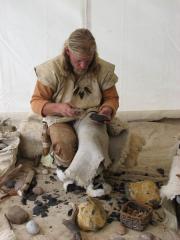
News Archive

Flint knapper at Whiteleaf
open day 2007Now in print – the excavations at Whiteleaf and Gayhurst
11 February 2008
Reports on these two important sites are now in print in Part 2 of Records of Bucks Volume 47 (2007). Two volumes of Records in one year is unusual, but then so are these two sites!
Gill Hey describes Oxford Archaeology’s survey and excavations on Whiteleaf Hill. The best-known feature on the hill is the famous cross, recently restored by the County Council. Oxford Archaeology examined the broader landscape including - perhaps of most importance - the Neolithic barrow at the top of the cross, first excavated in the 1930s by Scott. The barrow, over 5,000 years old, proved to be the oldest visible man-made monument in the county. The new work ‘demonstrated a 500 year sequence of activity’ associated with the barrow which had been constructed within woodland. Beneath it had been lain a single male burial within a wooden mortuary structure. The form of the barrow has now been restored.
Of two other ‘barrows’ examined, one proved to be a natural knoll which had been exploited in the late Neolithic for flint knapping, and the other a mound which had supported a post-medieval windmill. Also investigated were an enigmatic later prehistoric cross-ridge dyke, crossed by the main path through the site but largely unnoticed by visitors to the hill, and First World War period practice-trenches dug by soldiers in training. Finally, and quite unexpectedly, a Roman-period votive leaf, hints that we still have things to learn about the history of Whiteleaf Hill.
Andy Chapman of Northamptonshire Archaeology describes quite a different prehistoric landscape at Gayhurst beside the Great Ouse in the north of the county. Here in advance of gravel extraction seven Bronze Age ring-ditches, three pit-alignments (enigmatic prehistoric boundary features) and three Iron Age enclosures were excavated. These sites had been discovered by aerial photography.
All of these are of interest but the earliest and most striking monuments proved to be a double ring-ditch enclosing several phases of round barrow construction. The barrow contained a sequence of five central burials. The first had lain within an oak-lined chamber; this was followed by a further inhumation burial and later by three cremation deposits, the last placed in a Collared urn. This sequence is itself most interesting, but what makes it unique is that ‘its construction was marked by the deposition of some 300 cattle skulls, spread across the gravel mound …the lack of butchery marks suggests that they may have formed a symbolic feast for the dead rather than an actual feast for the living.’ This represents an enormous expenditure of resources and makes one wonder about the wealth of the local community and the status of the individual buried here about 4,000 years ago.
All Society members will receive a copy of this volume. Non-members can obtain a copy from the Society for £16.50 including postage and packing
|